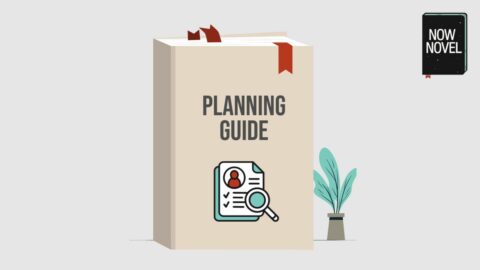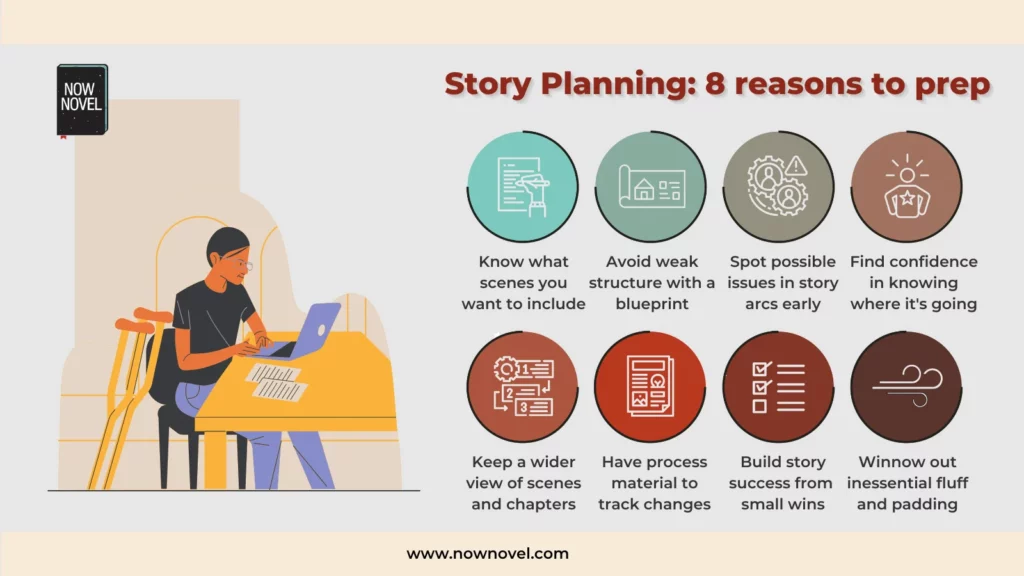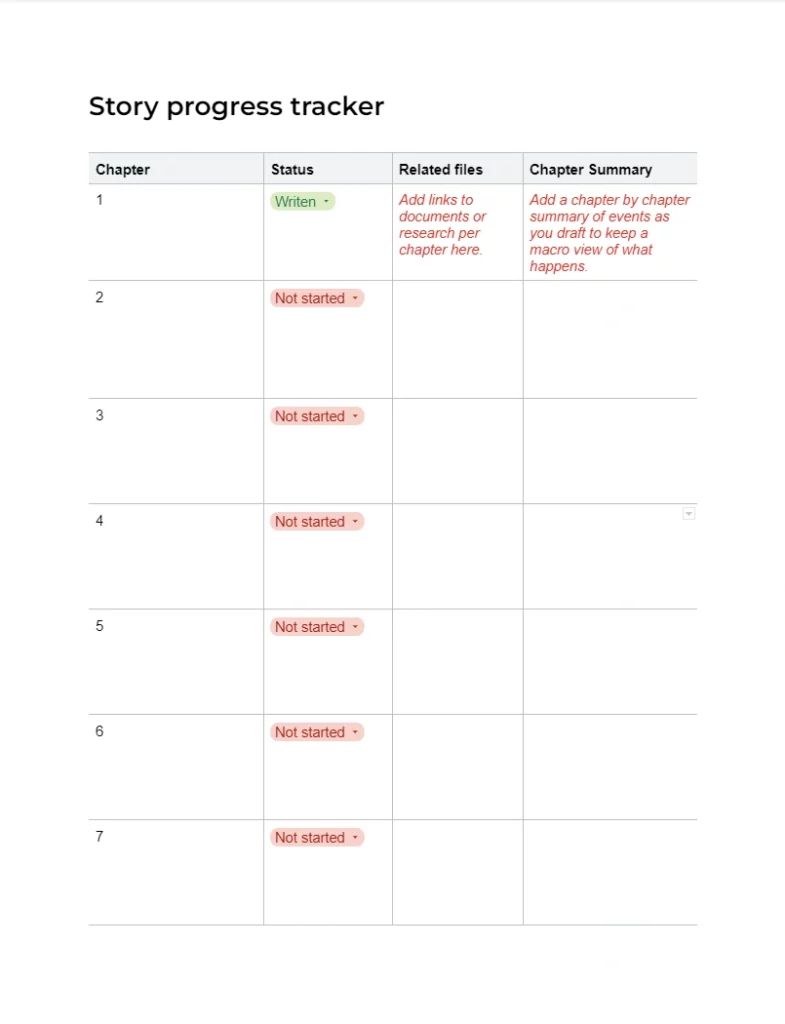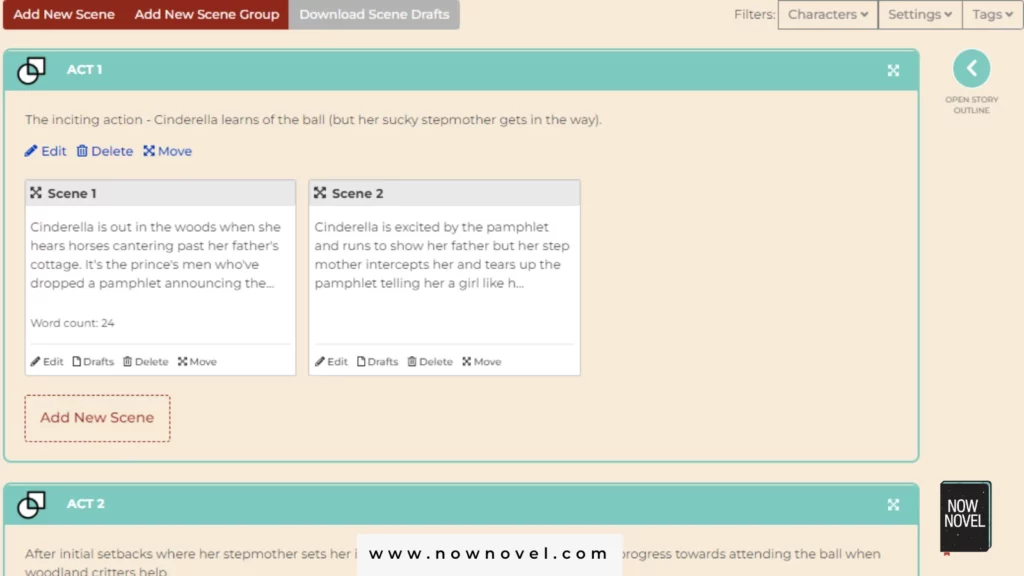This guide to story planning and outlining explores common planning terms and techniques in fiction writing, free and paid tools to plan your story, authors on their planning approaches, and more.
Key story planning terms
Explore common organizing terms you’ll find in articles and books on how to plan stories:
What are novel outlines and story maps?
A novel outline gives a simplified view of your story’s overarching arcs and development.
A working book title idea plus a wireframe to sculpt scenes upon helps stories take shape.
It could be a narrative version of your story written as a single page, a paginated PDF exported from a story planner (like Now Novel’s planning dashboard), a spreadsheet or visual plot diagram (often called a story map).
Your outline should provide a helpful overview of your story’s structure. It should also make drafting a more guided, structured part of the writing process.
What is brainstorming?
Generating ideas in a short space of time through creative exercises. Idea-generating activities that form the first step of the writing process (prewriting). For example:
- Freewriting: Writing down anything that comes to mind on a topic, scenario or prompt for a set time
- Answering questionnaires: A helpful way to brainstorm details about your story’s characters
- Mind-mapping: Writing high-level concepts (e.g. ‘love’) on a page, then linking ideas visually (e.g. ‘romance’, ‘meet cute’, ‘lovers’ conflicts’) to niche down and find further ideas
What are drafts and ‘draft zero’?
A draft or rough draft of your story is a completed version of your manuscript, prior to polishing such as editing and revision.
In story planning, the term ‘draft zero’ is often used to refer to a planning process in which you write a complete, rough draft without stopping to edit.
This gets the bare bones of your story down and helps you create foundations and parameters (more on this where we discuss outlining methods below).
What is storyboarding?
Storyboarding is a planning approach typically used in visual storytelling such as TV, film and advertising (though you can use it to write narrative fiction too).
You create frames in sequence representing story beats or moments in the timeline of a scene to plan plot events in visual terms.
What are plot templates?
Print-outs, PDFs, or writing tools structured to enable you to fill in predetermined event-types to plan a story.
For example, a romance plot template may include important beats for a romantic story such as:
- The meet cute: The moment future lovers first lock eyes
- The refusal/not a chance: For example, Lizzie Bennet being put off by Mr Darcy’s insulting initial behavior in Jane Austen’s 1813 Regency romance, Pride and Prejudice
- The second encounter: Another encounter during which romantic leads begin to understand each other better
Recommended reading
Find more on story outlining, brainstorming, planning first drafts and using story templates:
I don’t start a novel until I have lived with the story for awhile to the point of actually writing an outline and after a number of books I’ve learned that the more time I spend on the outline the easier the book is to write.
John Grisham
Make a Strong Start to your Book
Join Kickstart your Novel and get professional feedback on your first three chapters and story synopsis, plus workbooks and videos.
Learn More
Why outline stories? The plotter vs pantser debate
Why plan or outline stories at all?
There is a longstanding debate between the merits of plotting/planning books in advance vs ‘pantsing’ (noun: pantser). To ‘pants’ your novel means to write ‘by the seat of your pants’ – no story maps, no satnav.
Story planning pros: Reasons to prepare
‘Failing to plan is planning to fail’, and all that jazz.
Not necessarily – many writers do swear by a not-very-plotted process. In his interviews with The Paris Review, E.L. Doctorow said:
Writing is like driving at night in the fog. You can only see as far as your headlights, but you can make the whole trip that way.
E.L. Doctorow, quoted by Nancy Groves in ‘EL Doctorow in quotes: 15 of his best’ in The Guardian, Wed 21 July 2015.
You can make the whole trip that way (and props to your driving/writing skills if you do). However it’s also easy to take a wrong turn. Or get stuck in the ditch of a muddy middle. Planning your story means:
- Knowing what scenes you need to write.
- Avoiding weaker structure with more fixing required later.
- Being able to spot potential story arc issues sooner.
- Having greater confidence because you know where your story’s going.
- Keeping a wider view of scenes and chapters (your story’s overall cohesion).
- You keep process material that makes it easier to track and monitor structural changes and any necessary plan departures.
- You can build wins upfront (the planning) that set up momentum for your draft.
- You have a stronger chance to produce a rough draft that already has the padding taken out.
Pantser vs plotter compromise: Planning your way
What if you’re a veteran pantser and you love the freedom of the blank page, writing without fog lights?
If you prefer pantsing to plotting, you could do minimal planning to at least organize your writing process (if not the full plot):
- Outline one step ahead in pairs of action and reaction. This will help to ensure cohesion from scene to scene.
- Treat your pantsing first draft as a ‘draft zero’ – prep work for whatever you’ll keep for a second (if necessary more plotted) draft.
- Create a reverse outline as you go. Summarize the events of each chapter in a paragraph once you’ve written it. It will help you keep the total story cohesion in mind and remind you of what makes sense to follow.
- Plan scene-by-scene and chapter focus only. Character questionnaires and brainstorming in detail not for you? Use a corkboard (like the Now Novel Scene Builder) to just plan the basic events of each scene or chapter before you sit down to write, without extra preparation.
Have you found your own compromise between planning and pantsing stories that works? Share your approach in the comments.
Download a free story planning and progress tracker template we made in Google Docs.
(Go to the ‘file’ menu and select ‘make a copy’ of the file after logging in to your Google account to gain editing permissions and save a private version of the outline template to your own Google Drive).
Learn more about plotter and pantser approaches:
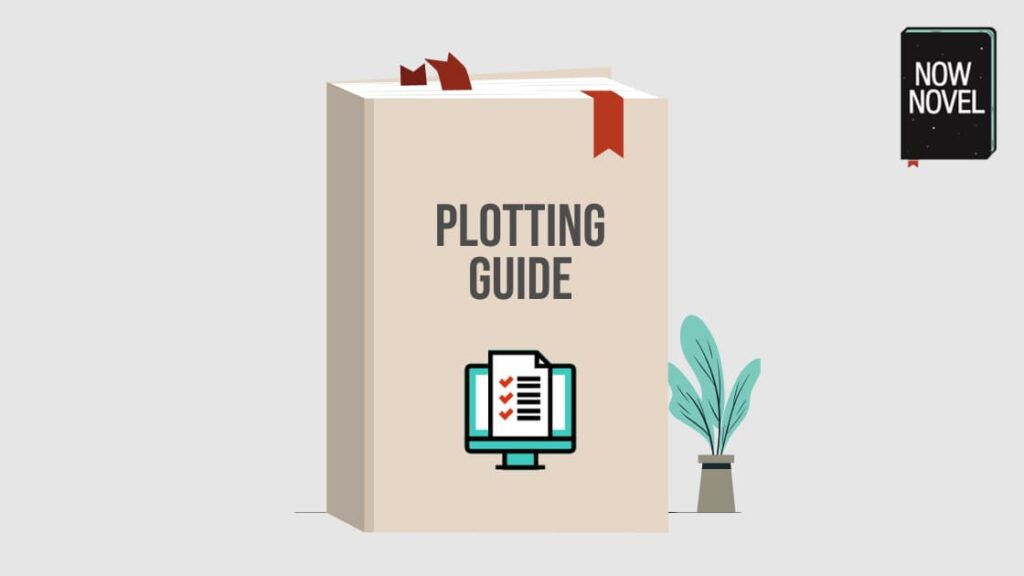
Story plotting and structure: Complete guide
Read more about story plotting and planning stories’ structure in our complete guide.

Common pantser writing challenges (and how to solve them)
Read more about common challenges pantsers face (and ways to overcome them).
I am a hopeless pantser, so I don’t do much outlining. A thought will occur to me and I’ll just throw it into the story. I tell myself I’ll worry about untangling it later. I’m glad no one sees my first drafts except for my poor editor and agent.
Marie Lu
Book planning methods: Becoming a story organizer
If you don’t want your poor editor and agent to wring their hands in despair, over a book that doesn’t materialize (or may flop without substantial development), planning helps you stay on top of your process.
Explore organizing factors in novels and methods for outlining your story below:
Story outlining techniques
There are several story outlining techniques you could try. You could:
1. Plan a story by writing a synopsis first
It may seem a strange idea to write a synopsis of a story you haven’t written yet. It’s a useful way to get the cogs of story whirring, though.
The Now Novel dashboard walks you through planning stories from your Central Idea into writing a one line, then one paragraph, then one page synopsis. The expanding of your idea unlocks further ideas and questions to answer.
2. Summarize scenes and sequels to outline connected chapters
If you prefer to outline scene by scene (a compromise with pantsing), scenes and sequels provide one way to organize your story.
In Techniques of the Selling Writer, Dwight Swain divides story units into ‘scenes’ and ‘sequels’. Each unit has three parts:
Scenes:
Scenes as units of action, says Swain, should contain a goal which leads to a conflict, then disaster.
Scene example
A man named Mr Lockwood goes to inquire about lodgings (goal) where he is treated inhospitably by his landlord Heathcliff and attacked by the landlord’s dogs (conflict). He cannot leave because they are snowed in for the night (disaster). This is the opening scene of Emily Brontë’s Wuthering Heights.
Sequels
According to Swain, a sequel consists of a reaction to the previous scene, then a dilemma, then a decision.
Sequel example:
Mr Lockwood goes to bed where he reads a woman named Catherine Linton’s diary (reaction to being snowed in). He dreams Catherine’s ghost is at the window begging to be let in. He is in a dilemma when his cries awaken his already grumpy, now angrier landlord. So he decides to walk in the yard until sunrise and depart (decision).
3. Plan scenes and chapters on index cards, post-its, corkboards
If you’re a visual planner or prefer a more physical planning activity, writing out summary index cards for scenes (like Vladimir Nabokov did) or using post-its and corkboards is useful.
When we chatted to mystery series author Dr Bonnie Traymore (whose first novel was developed with the help of our Kickstart your Novel course), Bonnie shared:
I used the services of Hedi Lampert who works for Now Novel and she gave me an idea of taking post-it notes and putting scenes on a whiteboard, and just kind of pasting it on, and that that worked pretty well for me.
I know there’s a lot of online stuff that you can do. But for me, the physical act of writing and putting it on got me off the computer and standing up because writing and sitting is such a sedentary process.
Author Bonnie Traymore, interviewed by Jordan Kantey for Now Novel.
4. Plan story beats in actions and reactions
If a novel planning approach using Swain’s scenes and sequels sounds too complex, try simple units of ‘action’ and ‘reaction’. Example:
Action: Evacuation order pamphlets rain down on a city.
Reaction: The city’s inhabitants including a blind protagonist must leave urgently. (All the Light We Cannot See by Anthony Doerr).
The reaction becomes the seed for new actions and reactions.
5. Use three-act structure (or modified three-act structure)
Three-act structure is an approach to story structure deriving from Aristotle’s theories on dramatic structure in Greek antiquity. The simple premise that a story should have a beginning, middle, and end.
Three-act structure is divided into:
- Act 1: This introduces core characters such as the protagonist and important figures in their life, as well as the inciting incident. The inciting incident is the event (or series of events) that urges your character to act/depart/commit to a goal.
- Act 2: The middle third of the story typically includes complications, conflicts, mistakes, discoveries. If the protagonist’s goal seemed straightforward before, Act 2 reveals it won’t be a cakewalk.
- Act 3: The final third of the story includes the climax (where conflict or complication reaches a peak) and denouement (unresolved plot threads resolve).
You could create a ‘Scene Group’ for each act in the Now Novel Scene Builder named ‘Act’ plus the act’s number.
Next, fill each act with scene cards describing actions and reactions to flesh out each act’s connected story events.
6. Plan using the Hero’s Journey
Many archetypal stories have similar narrative structure.
For example stories that follow ‘The Hero’s Journey’ (theorized by Joseph Campbell) or one of several modern versions of Campbell’s ideas (such as Dan Harmon’s simplified ‘Story Circle’).
Say, for example, you take a ten-part version of the hero’s journey.
The average length of a paperback novel is 80,000 words. Divide that by ten and you have a plan of 8000 words per each section of the heroic tale (Birth, Call to Adventure, Meeting the Helper, etc.).
7. Use other methods (MICE, the snowflake method, Saves the Cat)
There are various other story planning methods. Inevitably when we discuss outlining, someone will comment, ‘what about so-and-so’s approach?’
A few other fiction planning options you could explore:
The MICE quotient
Nothing to do with rodents, this plotting concept introduced by Orson Scott Card and developed by Mary Robinette Kowal (see a handy infographic on Kowal’s Patreon) divides stories into four types of event. These types may be linked and nested within one another:
- Milieu – events driven by place or location.
- Inquiry – events driven by questions your character has.
- Character – events driven by questions your character has.
- Event – events driven by action.
This is where plotting and planning stories can start to seem overwrought, too complicated.
Karen Woodward breaks down Scott Card’s story outlining method and Kowal’s refinement of it in helpful detail in a blog post series.
There is also Randy Ingermanson’s ‘Snowflake Method’ and Blake Snyder’s ‘Saves the Cat’ method (developed for screenwriting but adapted for novel-writing by Jessica Brody). We also have a comprehensive guide to using the ‘Save the cat’ method.
Recommended reading
Learn more about story structures that create payoffs for readers, structuring and organizing scenes, and more:
I’m a big fan of outlining. Here’s the theory: If I outline, then I can see the mistakes I’m liable to make. They come out more clearly in the outline than they do in the pages.
Cynthia Voigt
Tools to plan stories: Software and cloud-based help
Tools to plan and outline stories provide shortcuts while rendering story connections clearer.
Cloud-based story planning tools: Advantages
The pros of cloud-based story planning tools include:
- Safeguard story progress: There’s less chance of losing your story progress should your desktop or laptop system be lost, stolen or damaged (singer Lana Del Rey had to start a book for Simon & Schuster from scratch when her laptop was stolen!)
- Lightweight story planning: No having to install story planning software that may slow down your system, all your progress can be saved in your browser
- Access and add to ideas anywhere: You can plan your story on your phone then carry on using a desktop device or vice versa
Offline (software) story planning tools
The most popular offline or software-based story planning tools include Scrivener 3 by Literature & Latte (available for Mac and Windows) and Ulysses (for Mac devices including iPhone, iPad and Macbooks).
Advantages of software-based planning tools for stories include:
- Not needing an internet connection: This isn’t a major advantage given how ubiquitous internet access is now. But helpful if you’re going off grid (or want to turn off online distraction to write)
- Additional features and functionality: Many software-based story planning apps offer functionality such as exporting drafts to .mobi Kindle and other eBook formats
Which story planning software should you choose?
This really depends on your:
- Budget (do you prefer subscription-based tools or once-off licensing? What are effective planning tools worth to you?)
- Feature requirements (do you want to create a text-based outline or storyboard visually or a mixture of both?)
Many Now Novel members have said they use a combination of Scrivener and Now Novel’s story outlining dashboard for a mix of browser-based planning, feedback and writing craft information, plus offline drafting and book formatting and file conversion.
What do book planning tools cost?
It varies by platform. For the most popular software-based apps:
Scrivener: $49 for a once-off license
Ulysses: $5.99 per month or $39.99 per year
The Now Novel dashboard is a little different (read more eclectic). For $15 per month (accurate ‘The Process’ pricing as of October 2022), you get:
- Story planning tools with unlimited stories and storage: A downloadable, paginated PDF with links back to edit your outline from each section grows as you answer structured prompts
- Live writing webinars with authors and editors: Attend writing webinars and workshops (including first page workshops and other practical panels) with published authors and editors. Includes a growing archive of recorded sessions
- Weekly feedback from an editor in Now Novel groups on submissions to the Now Novel feedback community
- Exclusive subscriber newsletter with bonus content and member spotlights
What free novel planners are there?
Most tools have license or membership fees as hosting space, development, support and other features all have associated costs.
However you can also use free tools such as Google Docs and Google Sheets to plan stories.
How to plan stories using Google Docs
Google Docs offers several useful features that can be used to create summaries and outlines.
Story outlines with sidebar navigation
In Docs, create an outline with links to jump between sections such as chapters, scenes, acts, or wiki-like entries (for example, you could create a structured document with details on each of your story settings).
- Create a new Google Docs document.
- Give your plan a title such as ‘scene outline for [story name]’.
- Click the + next to SUMMARY to enter a summary of the purpose for this story-planning document.
- Click ‘Normal Text’ in the toolbar at the top to choose different sizes of heading to use. Each will add to your document’s sidebar, creating easy links to jump between sections of your outline (use a smaller-sized heading to create nested sections within larger ones, e.g. scene summaries within chapters).
Example of a Docs-based story plan
Here is a story plan created using the above approach:
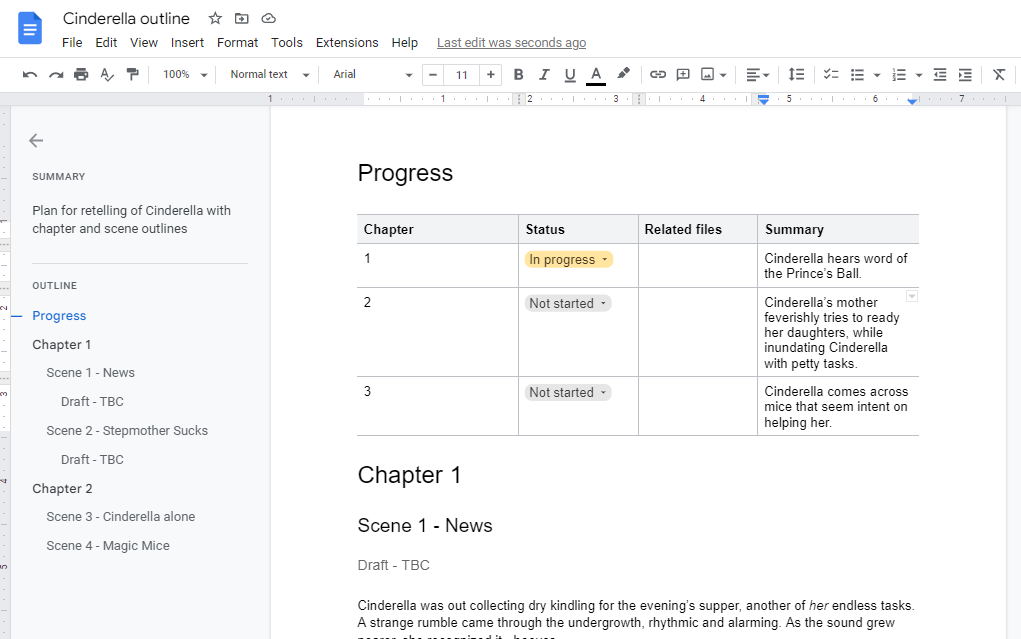
Creating a table for planning and tracking story progress
See the section under ‘progress’ above for checking off your story’s progress according to your plan? To create similar:
- Click ‘Insert’ in the top toolbar in Google Docs
- Navigate down to ‘Building Blocks’.
- Insert the block type called ‘product roadmap’ (your story plan is your product in this case).
- You can rename the standard column headers anything (in this case, ‘Project’ was renamed to ‘Chapter’).
- Rename the standard drop down selection items – click the drop down under the column ‘status’, then ‘Add/edit options’ and rename status options as you choose, then click ‘apply to all’ so that every row will have the same options.
How to plan stories in Google Docs with even more structure
To really level up your story planning in Docs (requires paid Now Novel membership), use Now Novel’s Google Docs add-on. This enables you to view your Now Novel outline in sidebar on the right as you draft per the screenshot below:
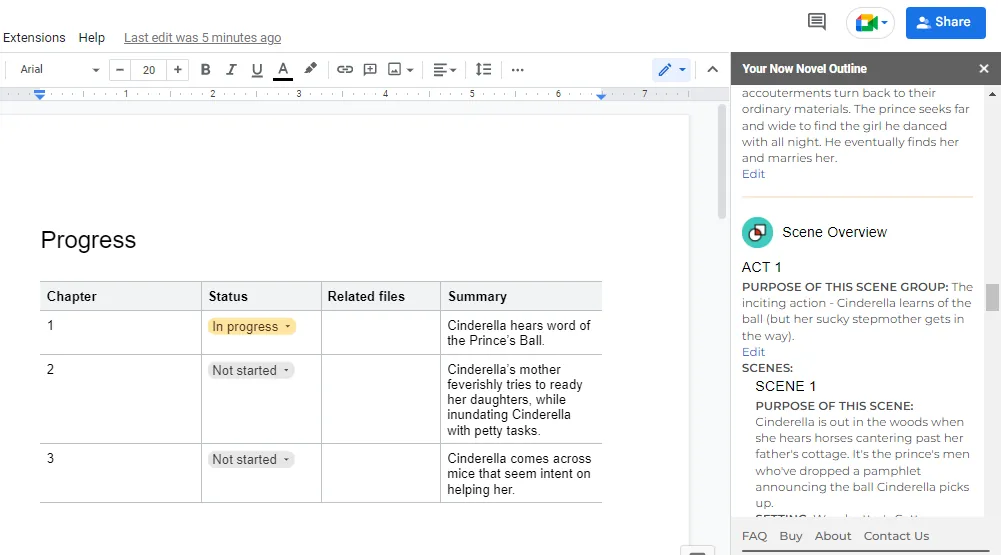
How to use your Now Novel story plan in Google Docs
- Click ‘Extensions’ in the top toolbar of your document.
- Navigate to Add-ons > Get add-ons.
- Search for ‘Now Novel’ and click ‘Install’ to add the add-on to your Google Docs. Confirm permissions to allow logging into your Now Novel account from within Docs.
- Under ‘Extension’, find ‘Now Novel’ and click ‘Start’.
- Sign into your Now Novel account using your Now Novel username and password.
If the above steps were successful, your currently active story outline should load. Find links back to edit each section from the sidebar, too, and all your characters, plot points, setting and scene ideas.
Recommended reading
Learn more about novel planning tools, Now Novel’s outlining dash and Google Docs add-on, and more:

Pay $0 for writing insights and how to’s
Be first to know whenever we publish and get bonus videos
and the latest Now Novel news.
Authors on planning books
There are (as the above examples show) many ways to plan books and shorter stories. The main thing is to find the method that works for you.
Read authors on the type of planning they do to write novels and other stories (and why they do it):
Sophie Hannah on why planning books is fun (and safer)
Crime author Hannah compares planning stories to doing home renovations:
The main reason I’m a planner is that it’s huge fun! It makes life SO much easier for a writer, and it gives you something concrete to look forward to. I would hate to start writing a novel with no clue as to what might happen from chapter to chapter, or how it might end. It would be like stripping the old wallpaper in your house and pulling up all the old carpets with literally no idea how you want the rooms to look at the end of the process
Sophie Hannah, ‘Why and How I Plan my Stories’
Kim Wilkins on planning solving any structural issues early
Dr Kim Wilkins is a senior lecturer in writing, editing and publishing at the University of Queensland.
In a podcast, she told the Australian Writers’ Centre:
Well, I’m a plotter, that’s how a book is written quickly and that’s how they come out the right shape, they don’t require much structural feedback, and you can just get on with the line edit and publish the damn thing.
Kim Wilkins, in conversation with Allison Tait for Australian Writers’ Centre.
I will brainstorm the beginning with a bunch of scenes, or brainstorm part of the middle, and then I plot maybe two chapters ahead, in quite a lot of detail. And that means that when I sit down to write, when I turn off the internet and have my two hours, I look at my notebook and I go, “OK, well, I’ve got to write a scene where Sam and Violet meet in secret and they go and dance in the empty ballroom while the snow falls
L. Sprague de Camp on why you should plan series
L. Sprague de Camp, a major figure in science fiction in America in the 1930s and 40s (who wrote over 100 books), stresses the importance of planning series in particular:
In writing a series of stories about the same characters, plan the whole series in advance in some detail, to avoid contradictions and inconsistencies.
L. Sprague de Camp, quoted by Rochelle Melander in ‘Write-A-Thon: Write Your Book in 26 Days (And Live to Tell About It)’, 2011.
Recommended reading
Read more advice from authors:
The best time for planning a book is while you’re doing the dishes.
Agatha Christie

GET YOUR FREE GUIDE TO SCENE STRUCTURE
Read a guide to writing scenes with purpose that move your story forward.
Learn moreWhat is a story planning question that’s been bugging you? Ask us via the comments below. Start creating a story plan now and view your outline in sidebar as you draft in our distraction-free Writing Pad or Google Docs.

